Related Research Articles

Physical therapy (PT), also known as physiotherapy, is one of the allied health professions. It is provided by physical therapists who promote, maintain, or restore health through physical examination, diagnosis, prognosis, patient education, physical intervention, rehabilitation, disease prevention, and health promotion. Physical therapists are known as physiotherapists in many countries.

Aerobics is a form of physical exercise that combines rhythmic aerobic exercise with stretching and strength training routines with the goal of improving all elements of fitness. It is usually performed to music and may be practiced in a group setting led by an instructor, although it can be done solo and without musical accompaniment. With the goal of preventing illness and promoting physical fitness, practitioners perform various routines comprising a number of different dance-like exercises. Formal aerobics classes are divided into different levels of intensity and complexity and will have five components: warm-up, cardiovascular conditioning, muscular strength and conditioning, cool-down and stretching and flexibility. Aerobics classes may allow participants to select their level of participation according to their fitness level. Many gyms offer different types of aerobic classes. Each class is designed for a certain level of experience and taught by a certified instructor with a specialty area related to their particular class.
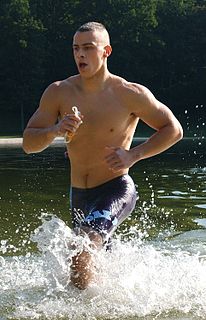
Exercise is any bodily activity that enhances or maintains physical fitness and overall health and wellness.

Music therapy, an allied health profession, "is the clinical and evidence-based use of music interventions to accomplish individualized goals within a therapeutic relationship by a credentialed professional who has completed an approved music therapy program."

Aerobic exercise is physical exercise of low to high intensity that depends primarily on the aerobic energy-generating process. "Aerobic" is defined as "relating to, involving, or requiring free oxygen", and refers to the use of oxygen to meet energy demands during exercise via aerobic metabolism adequately. Aerobic exercise is performed by repeating sequences of light-to-moderate intensity activities for extended periods of time. Aerobic exercise may be better referred to as "solely aerobic", as it is designed to be low-intensity enough that all carbohydrates are aerobically turned into energy via mitochondrial ATP production. Mitochondria are organelles that rely on oxygen for the metabolism of carbs, proteins, and fats.

Kinesiology is the scientific study of human body movement. Kinesiology addresses Physiological, Anatomical, Biomechanical, and Neuropsychological Principles and Mechanisms of Movement. Applications of kinesiology to human health include biomechanics and orthopedics; strength and conditioning; sport psychology; motor control; skill acquisition and motor learning; methods of rehabilitation, such as physical and occupational therapy; and sport and exercise physiology. Studies of human and animal motion include measures from motion tracking systems, electrophysiology of muscle and brain activity, various methods for monitoring physiological function, and other behavioral and cognitive research techniques.
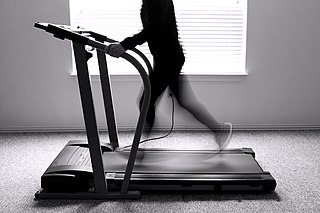
A treadmill is a device generally used for walking, running, or climbing while staying in the same place. Treadmills were introduced before the development of powered machines to harness the power of animals or humans to do work, often a type of mill operated by a person or animal treading the steps of a treadwheel to grind grain. In later times, treadmills were used as punishment devices for people sentenced to hard labor in prisons. The terms treadmill and treadwheel were used interchangeably for the power and punishment mechanisms.
Dance/movement therapy (DMT) in USA/ Australia or dance movement psychotherapy (DMP) in the UK is the psychotherapeutic use of movement and dance to support intellectual, emotional, and motor functions of the body. As a modality of the creative arts therapies, DMT looks at the correlation between movement and emotion.
Kenneth H. Cooper is a doctor of medicine and former Air Force Colonel from Oklahoma, who pioneered the benefits of doing aerobic exercise for maintaining and improving health. In 1966 he coined the term, and his book Aerobics was published in 1968, which emphasized a point system for improving the cardiovascular system. The popular mass market version was The New Aerobics (ISBN 0-553-26874-0), published ten years later.

An exercise ball is a ball constructed of soft elastic, typically in 5 diameters of 10-centimeter increments, from 35 centimeters to 85 centimeters, and filled with air. The air pressure is changed by removing a valve stem and either filling with air or letting the ball deflate. It is most often used in physical therapy, athletic training and exercise. It can also be used for weight training.
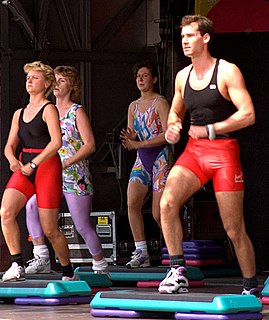
Step aerobics, also known as bench aerobics and step training, is a form of aerobic exercise that involves stepping on and off a small platform.
A Doctor of Physical Therapy or Doctor of Physiotherapy (DPT) degree is a qualifying degree in physical therapy. In the United States, it is considered a graduate level first-professional degree or Doctor's degree-professional practice. In the United Kingdom training includes advanced professional training and doctoral-level research.
Aquatic therapy refers to treatments and exercises performed in water for relaxation, fitness, physical rehabilitation, and other therapeutic benefit. Typically a qualified aquatic therapist gives constant attendance to a person receiving treatment in a heated therapy pool. Aquatic therapy techniques include Ai Chi, Aqua Running, Bad Ragaz Ring Method, Burdenko Method, Halliwick, Watsu, and other aquatic bodywork forms. Therapeutic applications include neurological disorders, spine pain, musculoskeletal pain, postoperative orthopedic rehabilitation, pediatric disabilities, and pressure ulcers.

A professional fitness coach is a professional in the field of fitness and exercise, most often instruction, including professional sports club's fitness trainers and aerobics and yoga instructors and authors of fitness instruction books or manuals.
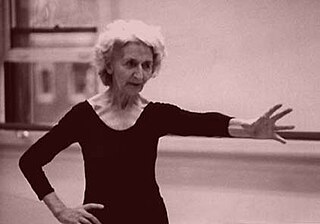
Irmgard Bartenieff was a dance theorist, dancer, choreographer, physical therapist, and a leading pioneer of dance therapy. A student of Rudolf Laban, she pursued cross-cultural dance analysis, and generated a new vision of possibilities for human movement and movement training. From her experiences applying Laban’s concepts of dynamism, three-dimensional movement and mobilization to the rehabilitation of people affected by polio in the 1940s, she went on to develop her own set of movement methods and exercises, known as Bartenieff Fundamentals.
Harold Dull (1935-2019) was an American aquatic bodyworker and poet best known as the creator of Watsu, originally developed in the early 1980s at Harbin Hot Springs, California. He is also known for his poetry, as founder of the Worldwide Aquatic Bodywork Association (WABA), and as creator of Tantsu and Tantsuyoga. Watsu is a form of aquatic bodywork in which a practitioner or therapist gently cradles, moves, stretches, and massages a receiver in chest-deep warm water for deep relaxation and aquatic therapy.
Submaximal performance testing is a way of estimating either VO2 max or "aerobic fitness" in sports medicine. The test protocols do not reach the maximum of the respiratory and cardiovascular systems. Submaximal tests are used because maximal tests can be dangerous in individuals who are not considered normal healthy subjects and for elite athletes maximal tests would disrupt training load balance.

Fitness culture is a sociocultural phenomenon surrounding exercise and physical fitness. It is usually associated with gym culture, as doing physical exercises in locations such as gyms, wellness centres and health clubs is a popular activity. An international survey found that more than 27% of world total adult population attends fitness centres, and that 61% of regular exercisers are currently doing "gym-type" activities. Getting and maintaining physical fitness has been shown to benefit individuals' inner and outer health. Fitness culture has become highly promoted through modern technology and from the rising popularity of social media platforms.
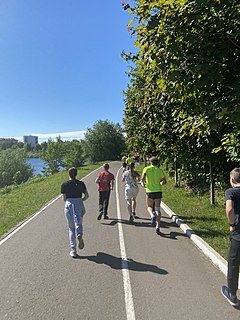
Outdoor fitness consists of exercise undertaken outside a building for the purpose of improving physical fitness. It contrasts with exercise undertaken inside a gym or health club for the same purpose. The activity may be undertaken in a park, in the wilderness, or other outdoor location. The popularity of outdoor fitness grew rapidly in the second-half of the twentieth century and grew as a commercial consumer market in the twenty-first century

Jacki Sorensen is the American originator of aerobic dancing, popularly known as aerobics. Inspired by Dr. Kenneth H. Cooper's 1968 book on aerobic exercise, she created for women an aerobic dance routine to music in 1969 in Puerto Rico, teaching U.S. Air Force wives. She expanded this concept into a teaching method and studio franchise, Aerobic Dancing Inc., that rose to 1,500 locations and 4,000 instructors teaching 170,000 students in 1981 at its peak.
References
- ↑ "Colonel Pauline "Polly" Potts Obituary (2013) The Arizona Republic". Legacy.com.
- ↑ Cooper, Kenneth H. (1968). The aerobics program for total well-being : exercise, diet, emotional balance. New York, N.Y. ISBN 9780307777256.